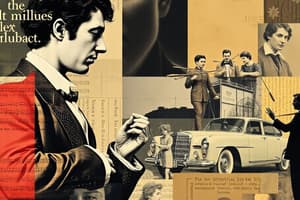Podcast
Questions and Answers
What type of music was popular during the Romantic Era?
What type of music was popular during the Romantic Era?
- Absolute music
- Program music (correct)
- Classical music
- Jazz
What is the definition of program music?
What is the definition of program music?
Instrumental music, often orchestral; tells a story through music; evokes particular feelings and associations.
What evokes particular feelings and associations?
What evokes particular feelings and associations?
Program music
What are examples of program symphonies?
What are examples of program symphonies?
What is a program symphony?
What is a program symphony?
What are examples of symphonic poems?
What are examples of symphonic poems?
What is incidental music?
What is incidental music?
What is the theme called in Symphonie Fantastique?
What is the theme called in Symphonie Fantastique?
Who wrote the Symphonie Fantastique?
Who wrote the Symphonie Fantastique?
What did Hector Berlioz turn into a musical masterpiece?
What did Hector Berlioz turn into a musical masterpiece?
Which composer is known today for program music and ballets?
Which composer is known today for program music and ballets?
What does the idée fixe represent in Symphonie Fantastique?
What does the idée fixe represent in Symphonie Fantastique?
What is the opposite of program music?
What is the opposite of program music?
Which composer was skilled in orchestration?
Which composer was skilled in orchestration?
What new instruments were included in Symphonie Fantastique?
What new instruments were included in Symphonie Fantastique?
Which composer consorted with bandits in Italy?
Which composer consorted with bandits in Italy?
Flashcards are hidden until you start studying
Study Notes
Program Music Overview
- Popular during the Romantic Era; characterized by storytelling through instrumental music.
- Defined as instrumental music, often orchestral, that evokes emotions and associations tied to events or themes.
Types of Program Music
- Program Symphony: A symphony consisting of three to five movements that depict a sequence of scenes or stories.
- Symphonic Poem: A one-movement orchestral work that expresses emotions or narratives, also known as tone poem.
- Dramatic Overture: An introductory movement for an opera or play, performed independently.
- Concert Overture: A standalone one-movement work intended for concert performance, closely resembling a symphonic poem.
- Incidental Music: Music played between acts in a play, enhancing the dramatic experience.
Key Composers and Works
-
Hector Berlioz:
- A pioneering figure in program music, known for his innovative orchestration and bold compositions that often required large ensembles.
- His famous work, Symphonie Fantastique, features a unifying theme called idée fixe, representing his beloved, and employs new instruments.
- Berlioz's life and works were influenced by literature, notably Shakespeare.
-
Peter Tchaikovsky:
- The most prolific late-19th-century program music composer; recognized for ballets and dramatic works.
- Known for pieces like The 1812 Overture, celebrated during American Independence Day.
- His Romeo and Juliet symphonic work uses sonata-allegro form and includes three main thematic elements.
Notable Characteristics and Innovations
- Program music often utilizes specific musical motifs to evoke specific feelings (e.g., lyrical melodies for love, dissonance for conflict).
- Symphonie Fantastique introduced novel playing effects (col legno, pedal tones) reflecting its dramatic narrative.
- The fifth movement, "Dream of the Witches' Sabbath," parodies the Dies irae chant, using contrapuntal techniques to depict tumultuous scenes.
Influence and Themes in Romantic Music
- The Romantic Era emphasized the supernatural and emotional expression through music.
- Program music is distinct from absolute music, which lacks a narrative or specific subject.
- Genres in program music differ primarily in their number of movements while still depicting a succession of scenes.
Summary of Key Terms
- Idée Fixe: A fixed idea or theme used in Symphonie Fantastique symbolizing the beloved.
- Symphonic Poems Examples: Notable works include Tchaikovsky's "Romeo and Juliet" and Strauss's "Thus Spoke Zarathustra."
- Examples of Dramatic Overtures: Mendelssohn's Overture to A Midsummer Night's Dream and Rossini's Overture to William Tell.
- Incidental Music Examples: Mendelssohn's and Grieg's pieces that enhance plays dramatically.
Composer Backgrounds
- Berlioz transitioned from studying medicine to music, highlighting his dedication to his craft.
- Tchaikovsky's ability to create memorable melodies suited him well for ballet compositions, evident in Swan Lake and The Nutcracker.
Contextual Insight
- The Romantic fixation on emotion and narrative led to the development and popularity of program music, reflecting the era's artistic ideals.
- These composers' works not only shaped the landscape of classical music but also influenced contemporary interpretations and performances.
Studying That Suits You
Use AI to generate personalized quizzes and flashcards to suit your learning preferences.




